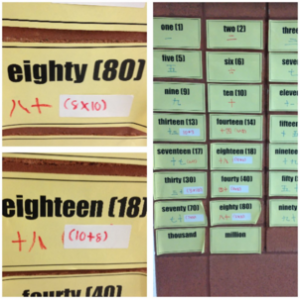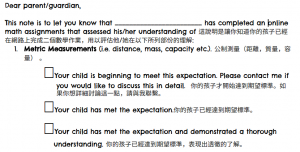This year I have the opportunity to serve my school as an English as Second Language (ESL) teacher for the first time. This privilege allows me to support students in Primary, Junior and Intermediate grades as they navigate the landscape of school and English language acquisition. But to be honest, I have alway been an ESL teacher. Since my very first year of teaching, my classes have always had students for whom English was not their first language. In this way, we are all ESL teachers regardless of if we have the designation or not. Similarly, if we take the notion of learning English literally, all of our students are English Language learners because they are constantly being introduced to new vocabulary and are learning the nuances of academic language for oral communication, reading and writing. In Ontario, however, the term English Language Learner or ELL, is defined as a student “born in Canada or newcomers whose first language is other than English or is a variety of English significantly different from that used for instruction in Ontario schools” (Many Roots, p. 51). Knowing this, how might classroom teachers tweak their practice to make their classrooms ELL friendly? I offer 4 easy teacher practices that will support ELLs in any classroom.
1. Keep expectations developmentally appropriate.
The ways we view our students determines the kind of learning we invite them to. This sentiment is particularly important to understand when designing programs that address the learning needs of students for whom English is a new language. Learning a new language, by any account, is a task of both perseverance and determination. As such, we need to be mindful that our English language learners have a multitasked learning situation. Focusing on the skills they bring from their native language as opposed to the limitations they have as they acquire English nurtures an asset based approach to engaging students as capable learners. When we embrace this mindset towards teaching English language learners, we can maintain high expectations for all students. Valuing the prior learning of all students, including ELLs in imperative in building upward to new understandings. Inviting students to share what they already know about a topic is always a great starting point for learning. Students who are English language learners have prior knowledge and this knowledge may or may not exist in their native Language. Regardless, valuing students’ prior knowledge solidifies the difference between cognition and language acquisition as two separate and distinct processes. For the most part, English language learners are developmentally ready for the learning that their peers are engaged in – they simply need to acquire the English skills to make the thinking that is already taking place in their minds visible in English.
2. Value students’ first language.
Nurturing an inclusive classroom community lets students know that they are both valued and respected as learners. Inviting students to continue to use and develop their native language is another way not only to accommodate ELLs but also to keep the learning expectations high. When students are able to use their native language to demonstrate their understanding and thinking in tasks that invite cognitive demand, the transition to English does not lower the expectation but rather accommodate the student’s opportunity for engaging deeply with ideas. The English language is further acquired when students translate their thoughts into English rather than the other way around. Valuing students’ first language can also be demonstrated by creating dual language or multilingual learning resources. With the partnership of students who are also native speakers of additional languages, parent volunteers, colleges and community partnerships, teachers can prepare translated learning resources for all students to use.
Students are invited to participate in collaborative learning experiences by expressing their ideas using their first language
Dual Language posters translated in traditional Chinese to support English Language learners in my class.
3. Develop new vocabulary in context with the help of online resources.
When students are invited to continue to use and development their fluency of their native languages, teachers can employ many new technologies that can support English acquisition while yet maintaining native language fluency. Using tools such as Google Translate can serve as a bridge between a student’s first language and English. Similarly, introducing new vocabulary in context makes both social academic learning more meaningful in English. An idea or word may not be unfamiliar to a student learning English in that they may already have an understanding of the concept in their native language. When this happens, using tools such as Google Images and YouTube can serve as a bridge to comprehension of and acquiring English words. Word walls are also useful resources for students in all grade levels and for all subject areas. It is a tool to support students as they acquire new vocabulary in the context of their learning. In this way, all students can be viewed as English language learners as they engage in expanding their academic vocabulary. The inclusion of students’ native language on word walls is a simple accommodation that goes a long way to supporting student learning. The gesture speaks to the value for the student’s native language and a respect for the process of learning English. Native English speakers can also benefit from the dual language approach in that they can be exposed to the languages of the world and additional ways of knowing.
I asked my students to add Chinese translations to our Math word wall. This highlighted the relationships between numbers, as the ideas of addition and multiplication are embedded in the ways Chinese numerals are written.
This is a screenshot of what a Grade 2 student, a stage 1 ELL, wrote as she was communicating an idea with me. I used Google Translate to take a picture of her writing and was able to translate and further communicate with her.
4. Embrace inclusive practices when communicating with parents.
When a student is an English language learner, it is important to also be aware of their parent or guardian’s experience with English as well. Whenever possible, supporting parents in the journey of their child’s language acquisition should be considered. Using resources mentioned above in addition to school-board translators and parent volunteers when communicating with parents is also crucial when English is also being acquired by parents. Ensuring that partnerships between students, teachers and parents is essential for the success of all children. We should be mindful to support parents who are English language learners in the context of the kind of communication that goes home, the necessary accommodations in place for parent-teacher meetings and the information needed for navigating the Ontario school system are essential in order to leverage the playing field for success.
The first page of a presentation to the parents of my students during Curriculum Night.
An assessment report sent home as communication to parents about student achievement.
Teachers in Ontario school are all ESL teachers and our students all, English language learners. Designing classroom spaces and learning opportunities with the principles of universal design will support English language learners but also enhance the learning experience of native English speakers. Keeping learning expectations high for all students, valuing students native languages and inviting parents as partners are essential ingredients to providing an enriched learning experience for English language learners. For more information check out the ministry document Many Roots Many Voices:Supporting English Language Learners in Every Classroom A Practical Guide for Ontario Educators https://www.edu.gov.on.ca/eng/document/manyroots/manyroots.pdf.







Thank you SO much Tisha for this really easy to understand and critical piece on supporting ELLs in our mainstream classrooms. You’ve shared some easy-to-apply tips as well as embedding meaningful learning for your students in your classroom.
I’m reminded by your suggestions, with what Dr. Jim Cummins would say…”What language do students think in?” So often, in the rush and fast pace of our classrooms, we forget that not all students are thinking in English.
Thank you so much for your contribution! Very best wishes for the rest of your year!